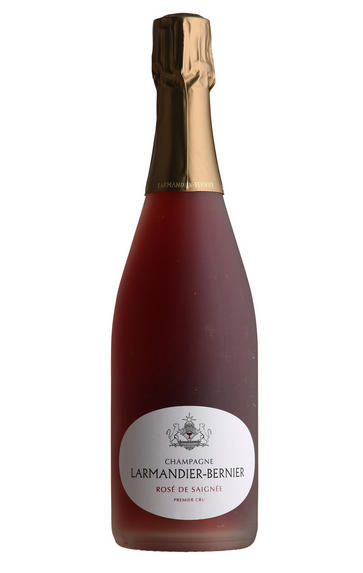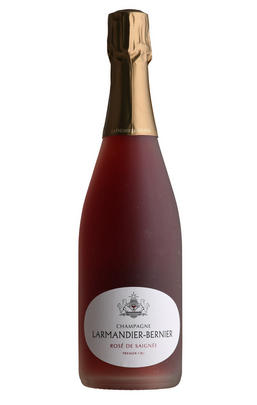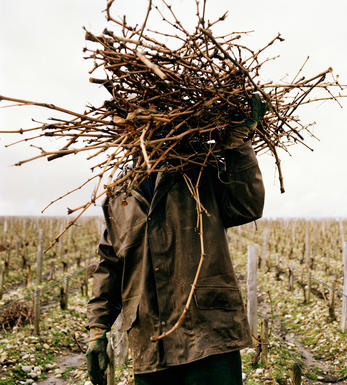
Champagne Larmandier-Bernier, Rosé de Saignée, 1er Cru, Extra Brut

Critics reviews
The dosage is 2 grams per litre. Disgorged: February, 2023.
The NV Extra Brut Rosé de Saignée is a pretty wine. Cinnamon, spice, crushed rose petals and dried herbs all grace this nuanced, understated Champagne. In this release, the Rosé is distinctly aromatic and savoury (although it was done with fully destemmed fruit). The blend also incorporates 10% Pinot Gris and, of course, the hand of the current generation, brothers Arthur and Georges Larmandier. The 2020 is decidedly on the lighter side for this bottling.
The Larmandier-Bernier wines are marked by a feeling of textural intensity and vinous resonance that is quite distinctive. The wines are fermented in wood, mostly larger format foudre with some smaller barrels, with spontaneous fermentations and generally minimal handling. Dosage is on the low side. In recent years, the style here has shifted towards a greater focus on energy and tension than in the past, likely a reflection of a generational change being led by Pierre and Sophie Larmandier’s sons Arthur and Georges. The wines remain compelling.
Drink 2023 - 2030
Antonio Galloni, Vinous.com (November 2023)
A blend of Pinot Noir with 10-15% Pinot Gris, co-planted ten years ago, amongst 45-year-old vines.
The nose is very floral with papaya and pink grapefruit, some praline and fresh, rose-like florals. The palate has the same hit of fragrant roses with plenty of peaches and a silky, smoothly textural palate. The entire parcel is macerated for between three and four days, for texture more than color. Very unique.
Drink now
James Suckling, JamesSuckling.com (September 2019)
About this WINE

Champagne Larmandier-Bernier
Pierre Larmandier’s reputation continues on its upwards trajectory and La Maison Larmandier Bernier is now perceived as one of the greatest addresses in Champagne.
The ingredients for this success are many and varied; biodynamic viticulture, wonderfully old vines, fantastic locations and aspects for the vines, and a non-intervention approach in the winery to mirror the respect for nature in the vineyards.
Nothing out of the ordinary on the face of it, but when all elements are joined together the results are little short of outstanding. The perfect expression of the purest Chardonnay.

Rosé Champagne
Rosé wines are produced by leaving the juice of red grapes to macerate on their skins for a brief time to extract pigments (natural colourings). However, Rosé Champagne is notable in that it is produced by the addition of a small percentage of red wine – usually Pinot Noir from the village of Bouzy – during blending.
Recommended Producers : Billecart Salmon (Elizabeth Salmon Rose), Ruinart

Champagne blend
Which grapes are included in the blend, and their proportion, is one of the key factors determining the style of most Champagnes. Three grapes are used - Pinot Noir, Chardonnay and Pinot Meunier.
26% of vineyards in Champagne are planted with Chardonnay and it performs best on the Côtes des Blancs and on the chalk slopes south of Epernay. It is relatively simple to grow, although it buds early and thus is susceptible to spring frosts. It produces lighter, fresher wines than those from Burgundy and gives finesse, fruit and elegance to the final blend. It is the sole grape in Blancs de Blancs, which are some of the richest long-lived Champagnes produced.
Pinot Noir accounts for nearly 40% of the plantings in Champagne and lies at the heart of most blends - it gives Champagne its body, structure, strength and grip. It is planted across Champagne and particularly so in the southern Aube district.
The final component is Pinot Meunier and this constitutes nearly 35% of the plantings. Its durability and resistance to spring frosts make the Marne Valley, a notorious frost pocket, its natural home. It ripens well in poor years and produces a soft, fruity style of wine that is ideal for blending with the more assertive flavours of Pinot Noir. Producers allege that Pinot Meunier lacks ageing potential, but this does not deter Krug from including around 15% of it in their final blends.


Buying options
Add to wishlist
Description
The dosage is 2 grams per litre. Disgorged: February, 2023.
The NV Extra Brut Rosé de Saignée is a pretty wine. Cinnamon, spice, crushed rose petals and dried herbs all grace this nuanced, understated Champagne. In this release, the Rosé is distinctly aromatic and savoury (although it was done with fully destemmed fruit). The blend also incorporates 10% Pinot Gris and, of course, the hand of the current generation, brothers Arthur and Georges Larmandier. The 2020 is decidedly on the lighter side for this bottling.
The Larmandier-Bernier wines are marked by a feeling of textural intensity and vinous resonance that is quite distinctive. The wines are fermented in wood, mostly larger format foudre with some smaller barrels, with spontaneous fermentations and generally minimal handling. Dosage is on the low side. In recent years, the style here has shifted towards a greater focus on energy and tension than in the past, likely a reflection of a generational change being led by Pierre and Sophie Larmandier’s sons Arthur and Georges. The wines remain compelling.
Drink 2023 - 2030
Antonio Galloni, Vinous.com (November 2023)
wine at a glance
Delivery and quality guarantee